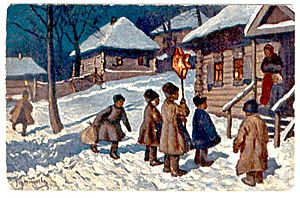Kolyadka facts for kids
Kolyadka are traditional songs sung during the Christmas season. People sing them in countries like Ukraine, Poland, and other parts of Eastern and Central Europe. Many believe that whatever is sung in a Kolyadka will come true.
Contents
History of Kolyadka
Kolyadka songs have a very long history. They were sung even before Christianity came to a region called Kievan Rus'. This was a powerful state in Eastern Europe many centuries ago. In those ancient times, Kolyadka had special ritual purposes. They shared old ideas about how the world was made. They also talked about nature and how the world worked.
When Christianity arrived, the songs started to change. Their words began to include religious meanings. They told stories from the Bible. Today, Kolyadka are mostly Christmas carols. They describe the birth of Jesus Christ and other related biblical events. But some of their older traditions from before Christianity are still part of them.
Kolyadka in Modern Culture
People in different countries sing Kolyadka in various ways. For example, in Serbia and Montenegro, people sing Kolyadka dedicated to Saint Nicholas in their churches. In Slovakia, the Czech Republic, and sometimes Belarus, Kolyadka are sung on Saint Nicholas Day (December 6). They are also sung on Saint Stephen Day (December 26).
Ukrainians sing Kolyadka from Saint Nicholas Day (December 19) until the holiday of Jesus' baptism (January 19). There are other winter holiday songs in Ukraine too. These include "schedrivkas" and "zasivalkas." While they have different purposes, in modern Ukrainian culture, these songs often mix together.
Kolyadka are also sung in countries where many people from Eastern Europe live. This includes places like Canada, where many Ukrainians have made their homes.
Kolyadka for Saints
In Ukraine, some Kolyadka are specially dedicated to Saint Nicholas. Here are a few examples:
- "Ой, хто, хто Миколая любить" (Who Loves Saint Nicholas)
- "Ходить по землі Святий Миколай" (Saint Mykolay Walks Around The World)
- "Миколай, Миколай ти до нас завітай!" (Mykolay, Mykolay, Come To Visit Us!)
"The Little Swallow"
One of the most famous Kolyadka (or schedrivka) in the world is the Ukrainian song "Щедрик." In English, it is known as "The Little Swallow." This carol has very old roots, going back to pre-Christian times.
A Ukrainian composer named Mykola Leontovych arranged this folk song in 1916. Later, an American composer named Peter J. Wilhousky adapted it into an English Christmas carol. This new song became known as "Carol of the Bells."
Wilhousky created "Carol of the Bells" after hearing the original Ukrainian song. It was performed by the Ukrainian National Chorus in Carnegie Hall in 1921. He wrote new English lyrics for the song in 1936. These new lyrics were not based on the original Ukrainian words.
The Ukrainian lyrics of "Shchedryk" fit the meaning of a schedrivka. However, the English lyrics of "Carol of the Bells" make it a Kolyadka or Christmas carol.
In 2016, a singer named Katie Melua and The Gori Women's Choir sang the original Ukrainian "Shchedryk" on the BBC.
See also
- "Shchedryk" (song)
- Koliada
- Koledovanie
- Ukrainian folk music


